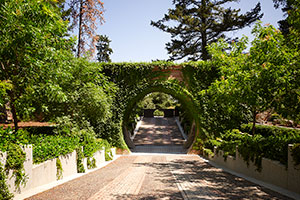Frequently Asked Questions

- In the middle of Napa Valley, California; north of Rutherford, south of Calistoga
- It is defined by Zinfandel Lane to the south, Bale Lane to the north, the intersection of Howell Mountain and Conn Valley Road to the east, and the 400-foot elevation line in the Mayacamas on the west
- Appellation St. Helena is comprised of roughly 12,000 acres, of which approximately 6,800 are planted to grapes - more than any other AVA in Napa Valley
- More than 400 different vineyards are located within the appellation
- Appellation St. Helena’s boundaries form an hourglass shape, and the middle section represents the narrowest width in the Napa Valley, where the Mayacamas and Vaca Mountain ranges nearly meet. This shape locks in heat during the day, amplifying the heat off the narrow hillsides, and funnels cool breezes at night, dropping temperatures dramatically – ideal growing conditions for fine wine grape growing
- Temperatures during the summer growing season typically reach the mid-90s during the day and drop to the 40s or 50s at night, creating a 40 to 50 degree spread. This climate enhances slow ripening, full maturity and promotes acid retention in the grapes, which results in a distinctive structure with supple and silky texture – a trademark of wines from St. Helena
- The St. Helena AVA is a mosaic of alluvial fans and 21 different soil types. The soils here are created from centuries of erosion of runoff from mountain hillsides and a formerly more powerful Napa River and its ancient tributaries. These geographical features have formed a diverse soil composition – unlike any other in the valley
- Consistency is the hallmark of St. Helena weather patterns, providing plentiful sunshine days and a longer than average growing season
- The appellation receives an average of 40 inches of rain per year, and atop the western Mayacamas Mountains, that total is nearly double, creating waterways that form our alluvial fans and rocky, well-drained soils
- The wines from Appellation St. Helena are known for naturally achieving seamless balance, power and elegance
- While many types of grapes excel in St. Helena, the most frequently cultivated are Cabernet Sauvignon, Cabernet Franc, Merlot, Syrah, Zinfandel, and Sauvignon Blanc
- Although there is no specific winemaking style in the appellation, the wines here often have similar characteristics because of the growing conditions. Such identifiers include pure, blue to black fruits that are deeply layered and devoid of green characters, concentrated coloring, good structure with balanced acid, ripe, luscious tannins with soft edges, and a supple, elegant texture
- St. Helena has the distinction of being the birthplace of Napa Valley’s commercial wine industry with Dr. Crane’s cellar founded in 1859, David Fulton’s in 1860 and Charles Krug’s in 1861
- In 1875 Charles Krug, Henry Pellet and Seneca Ewer organized the expanding group of local vintners and grape growers with the mission of working together to improve the quality of the wines coming from St. Helena, and in turn improving the reputation and demand for the wines
- The group called themselves the St. Helena Viticultural Club, later to be changed to the St. Helena Viticultural Society, and worked together with great success until around 1912
- In 2004, a group of St. Helena vintners revived the organization and later changed the name to Appellation St. Helena
To promote the quality of grapes grown and wines produced from the St. Helena AVA
